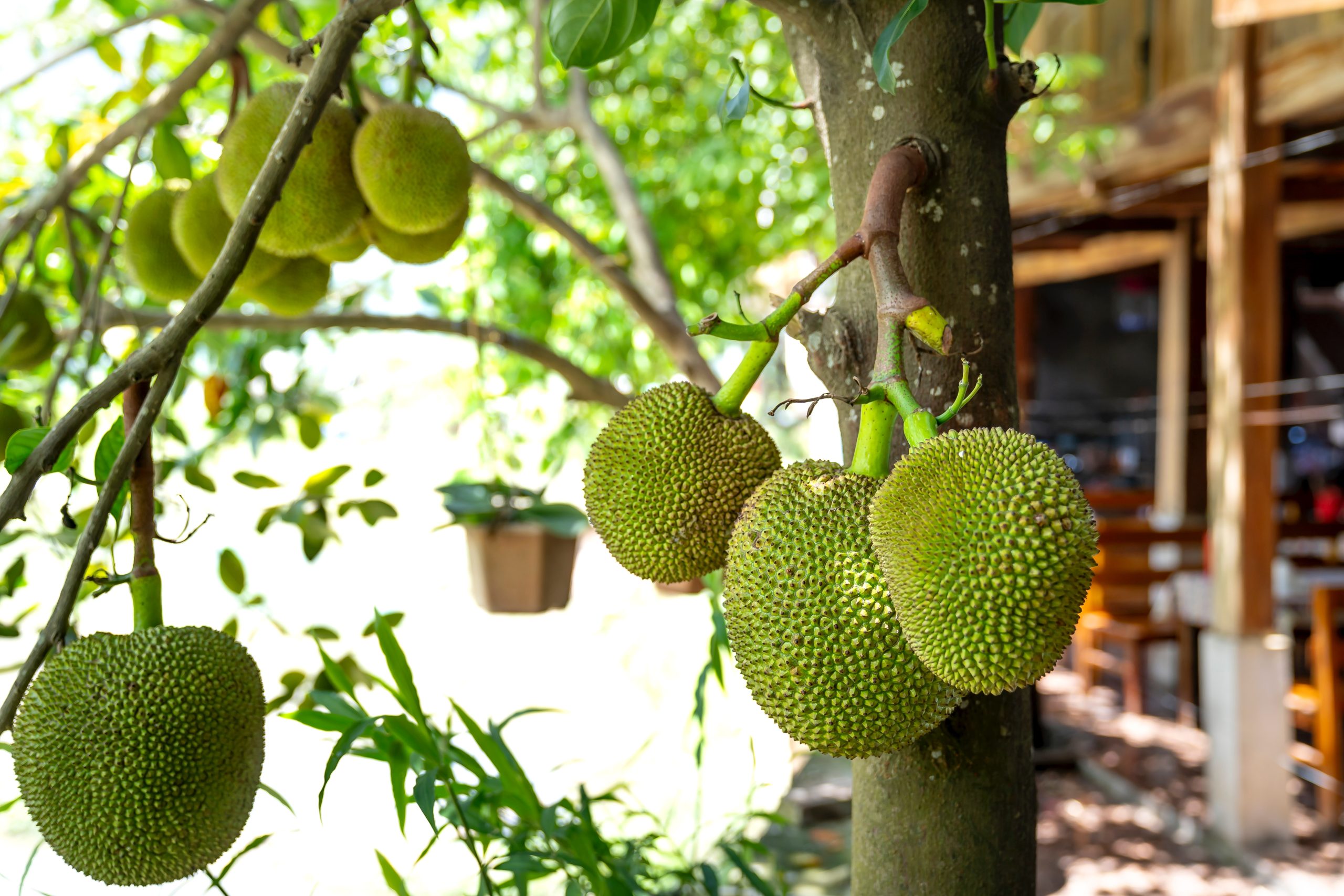In recent years, food gardening has been growing in popularity. More and more people are taking an interest in growing fruits and vegetables in their gardens, either for personal consumption or to sell at farmer’s markets.
According to The National Gardening Association report, 1 in 3 U.S. households grows food at home or in community gardens.
Among the different products that can be grown, jackfruit is an increasingly popular option. In 2021, the global jackfruit market produced over $297.77 million in revenue. And as its popularity continues to grow, it’s not surprising why it is widely cultivated around the world.
If you’re looking to add a jackfruit tree to your garden, here is a guide on how you can grow one from seed.
Is It Jack Fruit or Jackfruit?
With the scientific name Artocarpus heterophyllus, jackfruit is also called by many other names, such as the gold nugget and black gold. Many also refer to the fruit by its root word, jack, coming from its Malaysian name, chakka, which translates to fruit.
Jackfruit comes from the breadfruit family and is the largest fruit in the world. The average fruit can weigh between 30 to 50 pounds and measure up to 36 inches long and 20 inches wide. And inside its thick, spiky exterior is a yellowish flesh with a sweet taste often used in desserts and as an alternative to meat.
Many countries, including Bangladesh and Sri Lanka, identify jackfruit as their national fruit. However, Asian countries also grow jackfruit varieties that are often used for curries and other savory dishes. Aside from its flavorful flesh, jack fruits are also a good source of protein and can be boiled or roasted. With its nutritional value, jackfruit is considered the best meat substitute for vegetarians and vegans.
How Long Does It Take for Jackfruit To Bear Fruit?

Jackfruit trees usually take two to five years before they start bearing fruit. However, jackfruit cultivars or grafted varieties can produce fruit as early as three years.
Newly planted trees take time to grow before they can support the weight of the jackfruit. Once they mature, a jackfruit tree can produce up to 200 fruits in a season and can live for up to 100 years.
So, if you want to get a headstart on your fruit production, now is the best time to grow jackfruit trees from seed. This way, you can enjoy the fruits of your labor in just a few years.
How to Root Jackfruit Seeds
When growing a new tree, the root system is the most critical part. The roots are what absorb water and nutrients from the soil surface and anchor the tree to the ground.
To grow a strong and healthy jackfruit tree, you must start with strong and healthy roots. You can do so by following these steps:
- Choose the right type of seed.
- Plant the seeds in well-draining soil.
- Water the seeds regularly.
- Keep the soil moist but not soggy.
- Fertilize the roots monthly.
- Prune the roots regularly to encourage new growth.
- Monitor the roots for pests and diseases.
How Do You Choose Your Seeds?
Growing jackfruit from seed is relatively easy with the help of seeds from fresh jackfruit. Once you have your hands on some, the first step is to choose which ones to plant.
Pick out the plumpest and darkest seeds from the bunch, as they are more likely to germinate. You can also test if the seed is still viable by putting it in a bowl of water. If it sinks, then it is good to plant. If it floats, then it is best to discard it.
How to Plant Your Seeds

The next step is to start planting your seeds. If you’re growing jackfruit in pots, choose containers at least 12 inches wide and deep. Fill the pot with a well-draining potting mix, such as a mix of peat moss and perlite.
Plant two to three seeds per pot, making sure to plant them at least 1 inch deep. Water the soil until it is moist but not soggy. Place the pots in an area where they will get six to eight hours of direct sunlight a day.
After two to three months, the seedlings will start to grow. Thin them out so that only the strongest plant remains. When they are about 6 inches tall, transplant them into larger pots.
Where Is the Best Place for Planting Jackfruit?
Jackfruit trees require specific conditions to thrive. By understanding its ideal growing conditions, you can provide the jackfruit tree with the care it needs to produce fruits.
The best place to plant a jackfruit tree includes several factors, such as climate, humidity, soil type, and exposure to sunlight.
What is the Ideal Climate for Jackfruit?
Jackfruit trees are tropical plants. They can grow in a wide range of temperatures but prefer warm weather. They can tolerate temperatures as low as 32 degrees Fahrenheit but experience stress when it dips below 50 degrees Fahrenheit. The ideal temperature for jackfruit trees is between 70 and 80 degrees Fahrenheit.
What Type of Soil Is Best for Jackfruit?
The type of soil jackfruit trees thrive in is well-drained soil, such as sandy loam or clay loam. The tree’s roots need to be able to breathe to absorb the nutrients it needs, so soil moisture is a crucial factor. Jackfruit trees need at least 1 inch of rainfall or irrigation per week.
How Much Space Does a Jackfruit Tree Need?
A mature jackfruit tree can grow up to 30 feet tall and wide, so it is best to plant them at least 20 feet away from other trees or structures. If you are growing multiple jackfruit trees, plant them at least 35 feet apart to allow adequate room to spread. Large branches can grow up to 6 feet long, so it’s essential to give the tree enough space to grow.
Do Jackfruit Trees Need Full Sun?
Young trees need more sun than mature trees. They need at least six hours of direct sunlight daily but can survive with as little as four hours of daylight. But once the tree reaches maturity, it can tolerate partial shade.
How to Prune Jackfruit Trees

Young Jackfruit Trees
Young trees require little pruning. You can remove dead wood, diseased branches, or damaged twigs as needed. You can also cut off any suckers growing from the same tree.
Mature Trees
Once your jackfruit tree is established, you will need to prune it annually to encourage fruit production and prevent the branches from getting too heavy.
The best time to prune a jack tree is in late winter or early summer before the tree starts to produce fresh fruit. Use sharp pruning shears to remove affected branches and cut back any suckers growing from the roots, and trim back any branches that are crossing over each other.
Fruit Thinning
When the fruit matures in your tree, you may need to thin out the fruit to prevent the branches from breaking. The fruits can be quite large, hurting the tree if too many mature at once.
To thin the fruit, cut off any small fruits. You can also remove fruits that are misshapen or have blemishes. It will help the tree focus its energy on producing fewer but healthier jackfruits.
Other Ways to Care for a Jackfruit Tree
Fertilizer
Your trees need to be fertilized once a year, in the springtime. Use a balanced fertilizer that is high in nitrogen, phosphorus, and potassium. Apply the fertilizer around the drip line of the tree, taking care not to get any on the trunk.
Pest Control
Pests in your home can be a big problem. These small creatures can travel in and wreak havoc, destroying your garden and plants.
There are a few things you can do to control pests. The first is to remove any food sources they might be after. Keep your garden free of debris and fallen fruit. You can also discourage pests by making your garden less hospitable to them. Use mulch and row covers to keep pests out.
There are several chemical controls available to kill or repel pests. These should be used as a last resort, as they can harm both people and animals.
Disease Control
Diseases can also be a problem in your garden. The most common diseases affecting jackfruit plants are root rot and leaf spot.
Root rot is caused by a fungus that attacks the tree’s roots. This disease can be spread through contaminated soil or water. To prevent rotting tree roots, ensure your tree has well-drained soil and avoid overwatering. Mounding soil until it reaches the tree trunk can also help.
How Do You Know When a Jackfruit Is Ripe?
Ripe fruit should be yellow or brown and have a sweet, fruity smell. The fruit should also be slightly soft to the touch; this means the fruit already has an edible pulp. You can store ripe fruits at room temperature for up to two days. If the fruit is green, it is still an unripe jackfruit. In that case, leave the fruit to ripen for a few more days. An immature fruit will not taste as sweet as a ripe one.
How to Harvest Jackfruit

Once you have determined your tree bears a ripe jackfruit, you can harvest it by cutting the stem with a sharp knife. Be careful not to damage the tree as you cut.
After cutting the mature fruit from the tree, you can remove it by hand or with a tool. Afterward, you’re free to enjoy your delicious fruit.
Creating the perfect garden takes time, effort, and knowledge. With the right care, your trees will thrive and provide you with fresh products for years to come.




